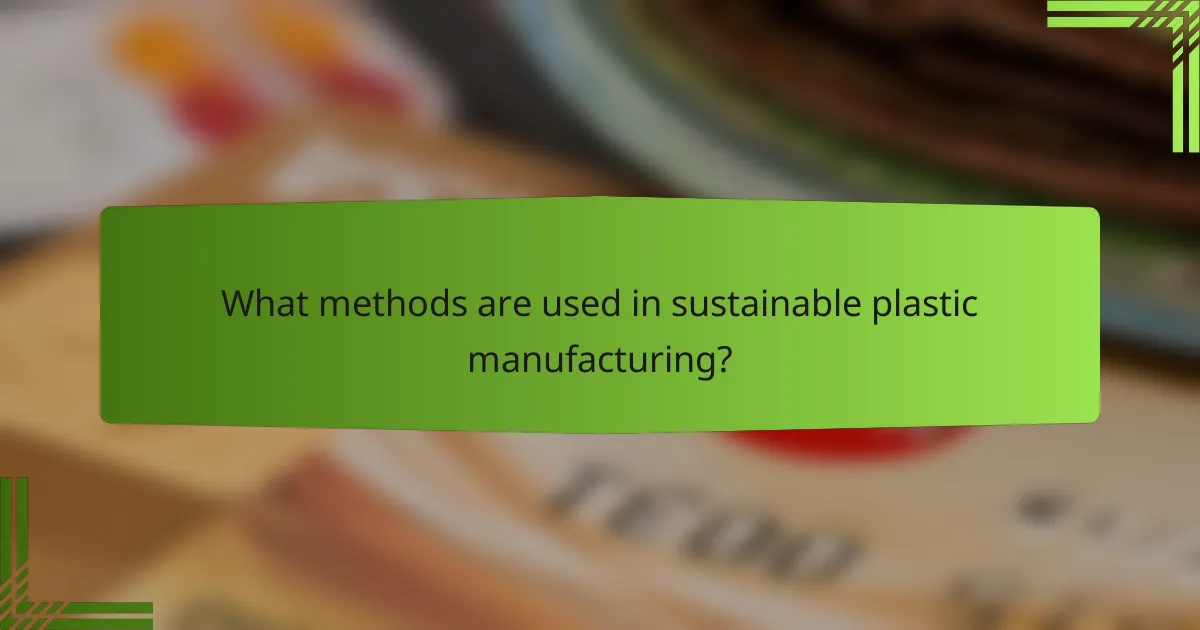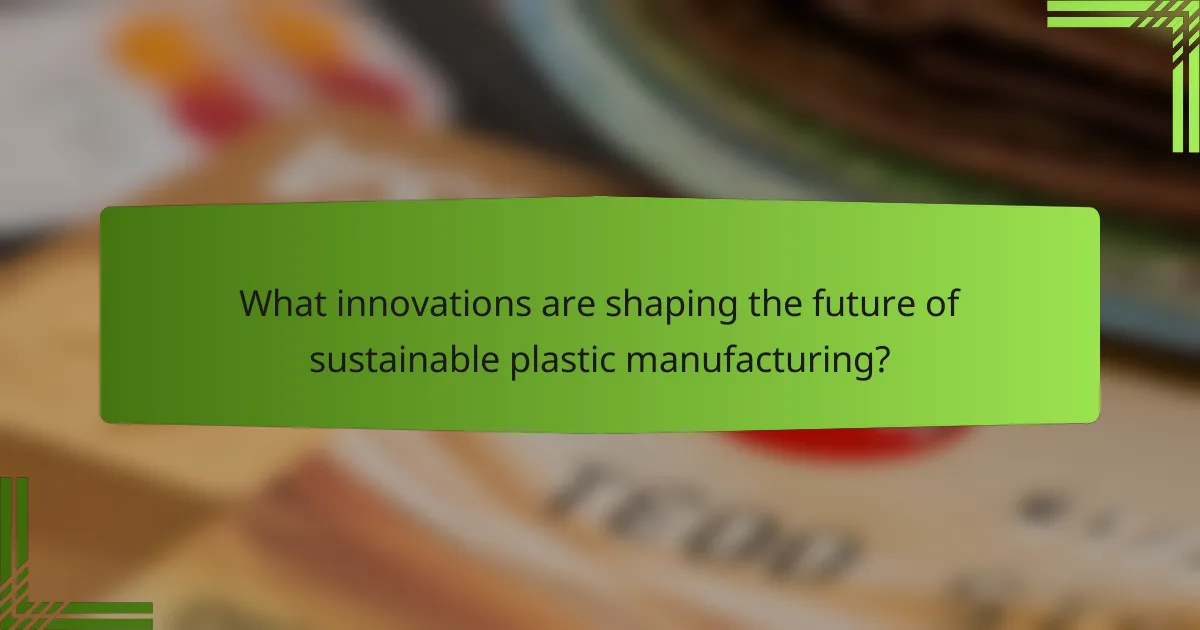Sustainable practices in plastic manufacturing encompass methods aimed at minimizing environmental impact through the use of recycled materials, energy-efficient processes, and waste management strategies. Key approaches include the production of bioplastics from renewable resources, advanced recycling technologies that enhance the processing of mixed plastics, and additive manufacturing techniques that reduce material waste. The benefits of these practices extend beyond environmental sustainability, offering cost savings and improved brand reputation for manufacturers. Research indicates that transitioning to a circular economy in plastics could yield significant economic advantages, with potential benefits reaching up to $4.5 trillion by 2030. Overall, sustainable practices are essential for fostering a more environmentally responsible and economically viable manufacturing landscape.

What are Sustainable Practices in Plastic Manufacturing?
Sustainable practices in plastic manufacturing involve methods that minimize environmental impact. These practices include using recycled materials, reducing energy consumption, and implementing waste management strategies. For example, utilizing post-consumer recycled plastics reduces the need for virgin materials. Energy-efficient machinery and renewable energy sources lower carbon emissions during production. Additionally, adopting biodegradable alternatives can reduce plastic waste in landfills. Implementing closed-loop systems allows for recycling and reusing materials within the production process. These practices not only support environmental sustainability but also can lead to cost savings for manufacturers. According to a report by the Ellen MacArthur Foundation, transitioning to a circular economy in plastics could generate $1 trillion in economic benefits.
How do sustainable practices impact the plastic manufacturing industry?
Sustainable practices significantly reduce environmental impact in the plastic manufacturing industry. These practices include using recycled materials, which decreases the demand for virgin plastics. For example, the use of recycled PET can lower energy consumption by up to 75%. Implementing biodegradable plastics also minimizes waste in landfills. Companies adopting these methods often enhance their brand image and attract eco-conscious consumers. Research indicates that sustainable practices can lead to cost savings in the long term. A report from the Ellen MacArthur Foundation states that transitioning to a circular economy could generate $4.5 trillion in economic benefits by 2030. Thus, sustainable practices not only benefit the environment but also provide economic incentives for the plastic manufacturing industry.
What are the key principles of sustainability in plastic manufacturing?
The key principles of sustainability in plastic manufacturing include reducing waste, using renewable resources, and promoting recycling. Reducing waste involves minimizing the amount of plastic produced and discarded. This can be achieved through efficient production processes and design for disassembly. Using renewable resources refers to sourcing materials from sustainable origins, such as bio-based plastics derived from plants. Promoting recycling encourages the recovery and reuse of plastic materials, which decreases the demand for new plastic production. A study by the Ellen MacArthur Foundation highlights that improving recycling rates can significantly reduce environmental impact. These principles collectively aim to create a circular economy in the plastic industry.
How does sustainability influence production processes?
Sustainability influences production processes by promoting eco-friendly practices and resource efficiency. Companies adopt sustainable materials to reduce environmental impact. This shift often includes using recycled plastics or biodegradable alternatives. Energy consumption is optimized through renewable energy sources. Waste reduction strategies are implemented to minimize landfill contributions. These practices can enhance brand reputation and customer loyalty. According to a 2020 report by McKinsey, sustainable practices can lead to a 20-30% reduction in production costs. Thus, sustainability not only benefits the environment but also improves economic efficiency in production processes.
Why is sustainability important in plastic manufacturing?
Sustainability is important in plastic manufacturing because it minimizes environmental impact. Sustainable practices reduce the depletion of natural resources. They also lower greenhouse gas emissions during production. Moreover, sustainable methods promote recycling and reuse of materials. According to the Ellen MacArthur Foundation, transitioning to a circular economy can reduce plastic waste significantly. This approach not only conserves resources but also fosters innovation in material development. Sustainable plastic manufacturing leads to better compliance with regulations and consumer expectations. Ultimately, it supports long-term industry viability and ecological health.
What environmental issues are addressed by sustainable practices?
Sustainable practices address several environmental issues, primarily pollution, resource depletion, and climate change. Pollution is reduced through cleaner production methods that minimize waste and emissions. Sustainable practices often involve using renewable resources, which helps mitigate resource depletion. Climate change is addressed by lowering greenhouse gas emissions through energy-efficient technologies. Additionally, sustainable practices promote recycling and waste management, further reducing environmental impact. According to the United Nations, sustainable development can significantly decrease environmental degradation and ensure a healthier planet for future generations.
How do sustainable practices improve corporate responsibility?
Sustainable practices enhance corporate responsibility by promoting ethical operations and environmental stewardship. Implementing these practices reduces waste and lowers carbon footprints. Companies adopting sustainable methods often experience increased consumer trust. Research shows that 66% of consumers are willing to pay more for sustainable brands. These practices can lead to improved employee morale and retention. Furthermore, sustainability initiatives often result in cost savings through efficient resource use. Companies that prioritize sustainability can enhance their brand reputation significantly. This alignment with social values attracts investors and partners focused on responsible business practices.

What methods are used in sustainable plastic manufacturing?
Sustainable plastic manufacturing employs methods such as bioplastics production, recycling, and energy-efficient processes. Bioplastics are derived from renewable resources like corn starch or sugarcane. This reduces reliance on fossil fuels and lowers carbon emissions. Recycling processes involve reusing plastic waste to create new products. This minimizes landfill waste and conserves raw materials. Energy-efficient manufacturing techniques reduce energy consumption during production. These methods can lower greenhouse gas emissions significantly. According to the Ellen MacArthur Foundation, effective recycling can reduce plastic pollution by up to 70%.
What are the most common sustainable manufacturing methods?
The most common sustainable manufacturing methods include additive manufacturing, closed-loop recycling, and biomanufacturing. Additive manufacturing, also known as 3D printing, reduces waste by using only the necessary materials for production. Closed-loop recycling involves reprocessing waste materials back into the production cycle, minimizing resource extraction. Biomanufacturing utilizes biological processes, such as fermentation, to create products sustainably. These methods contribute to reducing environmental impact and resource depletion in manufacturing processes.
How does recycling play a role in sustainable plastic manufacturing?
Recycling significantly contributes to sustainable plastic manufacturing by reducing the need for virgin materials. It allows manufacturers to reuse existing plastic, which lessens environmental impact. According to the Ellen MacArthur Foundation, using recycled plastics can save up to 70% of energy compared to producing new plastics. Recycling also minimizes waste, diverting plastics from landfills. In 2020, only 9% of plastic waste was recycled globally, highlighting the potential for improvement. Enhanced recycling technologies can further improve recovery rates and quality of recycled materials. This shift supports a circular economy, where materials are continuously reused. Thus, recycling is essential for sustainable practices in plastic manufacturing.
What innovative materials are being used in sustainable practices?
Biodegradable plastics and bioplastics are innovative materials used in sustainable practices. These materials are derived from renewable sources such as corn starch, sugarcane, and potato starch. Biodegradable plastics break down more quickly than traditional plastics, reducing landfill waste. Research shows that they can decompose in industrial composting facilities within months. Additionally, recycled plastics are increasingly being utilized in manufacturing. This practice reduces the need for virgin plastic production, conserving resources. Innovations like mycelium-based materials are also emerging. Mycelium, the root structure of fungi, can be grown into packaging and insulation products. These materials provide alternatives to petroleum-based plastics, supporting environmental sustainability.
How do manufacturing processes minimize waste?
Manufacturing processes minimize waste through techniques such as lean manufacturing and recycling. Lean manufacturing focuses on reducing excess production and improving efficiency. This method emphasizes value creation while eliminating non-value-added activities. Techniques like just-in-time inventory reduce overproduction and excess materials. Recycling within manufacturing processes reuses materials, decreasing the need for new resources. For instance, in plastic manufacturing, post-consumer recycled plastics can be reprocessed into new products. According to the Ellen MacArthur Foundation, adopting circular economy principles can significantly reduce waste in manufacturing. These strategies collectively lead to a more sustainable production cycle.
What techniques are employed to reduce energy consumption?
Techniques employed to reduce energy consumption include energy-efficient machinery and process optimization. Energy-efficient machinery utilizes advanced technology to minimize power usage. Process optimization involves streamlining manufacturing steps to reduce waste and energy use. Implementing insulation and heat recovery systems can also significantly lower energy needs. Utilizing renewable energy sources, such as solar or wind, further decreases reliance on fossil fuels. Regular maintenance of equipment ensures optimal performance and energy efficiency. Employee training on energy conservation practices enhances overall awareness and reduces consumption. According to the U.S. Department of Energy, these methods can lead to a 10-30% reduction in energy use in manufacturing processes.
How can companies implement closed-loop systems?
Companies can implement closed-loop systems by establishing processes to recycle materials back into production. This involves designing products for recyclability and using recycled materials in new products. Companies should collaborate with suppliers and customers to create a sustainable supply chain. They can also invest in technology that facilitates material recovery and recycling. Training employees on sustainable practices is essential for effective implementation. Monitoring and evaluating the closed-loop system’s performance ensures continuous improvement. According to a report by the Ellen MacArthur Foundation, closed-loop systems can significantly reduce waste and resource consumption in manufacturing.

What benefits do sustainable practices offer in plastic manufacturing?
Sustainable practices in plastic manufacturing offer several benefits. They reduce environmental impact by minimizing waste and lowering carbon emissions. Sustainable methods often use renewable materials, decreasing reliance on fossil fuels. Energy-efficient processes contribute to cost savings and reduced operational expenses. Implementing recycling initiatives promotes a circular economy, extending the lifecycle of materials. Additionally, sustainable practices enhance brand reputation, attracting environmentally conscious consumers. Research shows that companies adopting sustainable practices can see a 20% increase in customer loyalty. Overall, these practices lead to a more sustainable and economically viable manufacturing landscape.
How do sustainable practices enhance product quality?
Sustainable practices enhance product quality by integrating environmentally friendly materials and processes. These practices often lead to improved durability and performance of products. For instance, using recycled materials can result in higher quality plastics that meet stringent standards. Sustainable manufacturing reduces waste, which can improve the overall efficiency of production. Additionally, companies that adopt sustainable practices often invest in better technology and training. This investment leads to more precise manufacturing processes. Research shows that products made with sustainable methods often have a lower environmental impact. This can enhance brand reputation and customer loyalty, further driving product quality.
What are the long-term cost benefits of sustainability?
Sustainability leads to long-term cost benefits through reduced operational expenses and enhanced efficiency. Companies that adopt sustainable practices often experience lower energy and resource costs. For example, using renewable energy sources can decrease energy bills by up to 30%. Sustainable materials can also reduce waste disposal costs significantly. Research indicates that businesses implementing sustainability measures can save an average of 10-20% on overall operational costs. Additionally, sustainable practices can improve brand loyalty, leading to increased sales and revenue over time. These factors collectively contribute to a more profitable and resilient business model in the long run.
How do sustainable practices affect consumer perception?
Sustainable practices positively influence consumer perception by enhancing brand reputation. Consumers increasingly prioritize environmental responsibility in their purchasing decisions. A survey by Nielsen found that 73% of millennials are willing to pay more for sustainable products. Companies adopting eco-friendly practices often see increased customer loyalty. Additionally, transparent sustainability efforts can build trust with consumers. Brands like Patagonia demonstrate that commitment to sustainability can lead to a strong consumer connection. Overall, sustainable practices can significantly enhance how consumers view and engage with a brand.
What economic advantages do companies gain from sustainability?
Companies gain several economic advantages from sustainability. These include cost savings, enhanced brand reputation, and increased customer loyalty. Implementing sustainable practices often leads to reduced operational costs. For example, energy-efficient processes can lower utility bills significantly.
Sustainable sourcing can also minimize material costs over time. Companies that prioritize sustainability often attract environmentally conscious consumers. This can result in higher sales and market share. According to a Nielsen study, 66% of global consumers are willing to pay more for sustainable brands.
Additionally, sustainable practices can improve regulatory compliance and reduce risks related to environmental liabilities. Companies can also benefit from tax incentives and grants for adopting green technologies. Overall, sustainability not only supports environmental goals but also drives economic growth and profitability.
How can sustainability lead to new market opportunities?
Sustainability can lead to new market opportunities by fostering innovation and meeting consumer demand for eco-friendly products. Companies adopting sustainable practices often develop unique materials and processes. For instance, bioplastics made from renewable resources are gaining traction. The global bioplastics market is projected to reach $44.93 billion by 2026, according to a report by MarketsandMarkets. This demand creates avenues for businesses to differentiate themselves. Additionally, sustainability can enhance brand loyalty among environmentally conscious consumers. Companies that prioritize sustainability often experience increased customer engagement and trust. This shift can lead to expanded market share and new revenue streams.
What role does sustainability play in regulatory compliance?
Sustainability is crucial for regulatory compliance in plastic manufacturing. It ensures adherence to environmental laws and standards. Compliance often requires companies to minimize waste and reduce emissions. Sustainable practices help organizations meet these requirements effectively. For instance, the European Union’s Plastics Strategy mandates reduced plastic waste. Companies that adopt sustainable methods align with such regulations. This alignment mitigates legal risks and enhances brand reputation. Additionally, sustainable practices can lead to cost savings through resource efficiency. Thus, sustainability directly influences regulatory compliance in the industry.

What innovations are shaping the future of sustainable plastic manufacturing?
Innovations shaping the future of sustainable plastic manufacturing include bioplastics, recycling technologies, and additive manufacturing. Bioplastics are derived from renewable resources, reducing reliance on fossil fuels. Advanced recycling technologies enable the processing of mixed plastics, increasing recycling rates. Additive manufacturing, or 3D printing, minimizes waste by using only the necessary amount of material. These innovations contribute to a circular economy by promoting the reuse of materials. According to a report by the Ellen MacArthur Foundation, transitioning to a circular economy could generate $4.5 trillion in economic benefits by 2030.
What emerging technologies are driving sustainability in plastics?
Emerging technologies driving sustainability in plastics include bioplastics, recycling innovations, and advanced manufacturing techniques. Bioplastics are derived from renewable resources, reducing reliance on fossil fuels. Innovations in recycling, such as chemical recycling, enable the breakdown of plastics into their original monomers for reuse. Advanced manufacturing techniques, like 3D printing, minimize waste by using only the necessary materials. These technologies collectively contribute to a circular economy in the plastics industry. The global bioplastics market is projected to reach $44.93 billion by 2026, indicating significant growth in sustainable alternatives.
How are bioplastics changing the landscape of plastic manufacturing?
Bioplastics are transforming plastic manufacturing by providing sustainable alternatives to traditional petroleum-based plastics. They are derived from renewable resources such as corn starch, sugarcane, and potato starch. This shift reduces reliance on fossil fuels and decreases greenhouse gas emissions.
Bioplastics can biodegrade under certain conditions, offering a solution to plastic waste. For instance, polylactic acid (PLA) bioplastics can decompose in industrial composting facilities. The global bioplastics market is projected to reach USD 44.93 billion by 2026, reflecting growing demand.
Major companies are investing in bioplastic technologies, further driving innovation in the field. For example, Coca-Cola and Unilever are exploring bioplastics for packaging solutions. This trend indicates a significant shift towards environmentally friendly manufacturing practices.
What role does automation play in sustainable practices?
Automation enhances sustainable practices by optimizing resource use and minimizing waste. It streamlines production processes, leading to reduced energy consumption. Automated systems can monitor and adjust operations in real-time. This adaptability helps in maintaining efficiency and reducing emissions. For example, factories using automation have reported energy savings of up to 30%. Additionally, automation can improve material recycling rates. Automated sorting technologies enable more effective separation of recyclable materials. This results in higher quality recyclables and less contamination. Overall, automation plays a crucial role in advancing sustainability in manufacturing.
How can companies stay ahead in sustainable plastic innovations?
Companies can stay ahead in sustainable plastic innovations by investing in research and development. This focus allows them to create biodegradable and recyclable materials. Collaborating with environmental organizations can enhance their sustainability efforts. Implementing circular economy principles can also reduce waste and improve resource efficiency. Monitoring regulatory changes keeps companies compliant and competitive. Engaging consumers through education on sustainable practices fosters brand loyalty. Utilizing advanced technologies, such as AI and machine learning, optimizes production processes. These strategies collectively position companies as leaders in sustainable plastic solutions.
What strategies can businesses adopt to foster innovation?
Businesses can adopt several strategies to foster innovation. Encouraging a culture of creativity is essential. This involves providing employees with the freedom to explore new ideas without fear of failure. Implementing cross-functional teams can enhance collaboration. Diverse perspectives often lead to unique solutions. Investing in research and development is crucial for driving innovation. Companies that allocate resources to R&D typically see higher innovation rates. Additionally, leveraging customer feedback can guide product improvements. Engaging customers in the innovation process can yield valuable insights. Establishing partnerships with startups can also stimulate fresh ideas. Collaborations often bring new technologies and approaches. Finally, adopting agile methodologies allows businesses to adapt quickly to changes. Companies that embrace agility can respond to market demands effectively.
How can collaborations enhance sustainable practices in the industry?
Collaborations can enhance sustainable practices in the industry by pooling resources and expertise. When companies work together, they can share best practices and innovative solutions. This leads to improved efficiency and reduced waste. For example, partnerships can facilitate the development of eco-friendly materials. Collaborative efforts often result in economies of scale, making sustainable options more accessible. Additionally, joint initiatives can amplify the impact of sustainability programs. Studies show that companies engaged in partnerships achieve greater sustainability outcomes. According to the Ellen MacArthur Foundation, collaborative approaches can accelerate the transition to a circular economy in manufacturing.
What are best practices for implementing sustainable practices in plastic manufacturing?
Best practices for implementing sustainable practices in plastic manufacturing include using recycled materials and optimizing production processes. Companies should source post-consumer recycled plastics to reduce virgin plastic use. Energy-efficient machinery can minimize energy consumption during production. Implementing closed-loop systems can reduce waste and enhance material reuse. Regular audits of resource use can identify areas for improvement. Collaborating with suppliers to ensure sustainable sourcing is crucial. Training employees on sustainability practices fosters a culture of environmental responsibility. Lastly, investing in research for biodegradable alternatives can lead to innovative solutions in plastic manufacturing.
Sustainable practices in plastic manufacturing encompass methods aimed at reducing environmental impact, including the use of recycled materials, energy-efficient processes, and waste management strategies. Key principles include minimizing waste, utilizing renewable resources, and promoting recycling, which collectively contribute to a circular economy. The article explores the economic advantages of sustainability, such as cost savings and enhanced brand reputation, while discussing innovative materials like bioplastics and advancements in recycling technologies. Additionally, it highlights the role of automation and collaboration in fostering sustainable practices within the industry.


